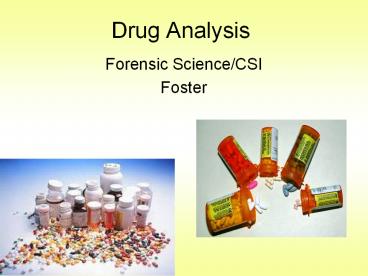Drug Analysis - PowerPoint PPT Presentation
Title:
Drug Analysis
Description:
Drug Analysis Forensic Science/CSI Foster How would you figure out which type of drug each of these are? Tests Drug Identification Screening or presumptive tests Spot ... – PowerPoint PPT presentation
Number of Views:595
Avg rating:3.0/5.0
Title: Drug Analysis
1
Drug Analysis
- Forensic Science/CSI
- Foster
2
How would you figure out which type of drug each
of these are?
3
Tests
Drug Identification
- Screening or presumptive tests
- Spot or color tests
- Microcrystalline test
- a reagent is added, producing a crystalline
precipitate that is unique for a certain drug - Chromatography
- Confirmatory tests
- Spectrophotometry
- Ultraviolet (UV)
- Visible
- Infrared (IR)
- Mass spectrometry
4
Forensics Unit 3 Notes
- Drug- a natural or synthetic substance designed
to affect the subject psychologically or
physiologically
Controlled Drugs- material whose possession is
controlled by law (Controlled Substances
Act)illegal- drug that is against the law to
have, use, or distribute.illicit- is a legal
drug used in an inappropriate or illegal way.
5
Controlled Substances Act
Dont write
- Schedule Ihigh potential for abuse no currently
accepted medical use in the U.S. a lack of
accepted safety for use under medical supervision - Examples heroin (diacetylmorphine), LSD,
marijuana, ecstasy (MDMA)
- Schedule IIhigh potential for abuse a currently
- accepted medical use with severe restrictions
abuse - may lead to severe psychological or physical
- dependence
- Examples cocaine, morphine, amphetamines
(including - methamphetamines), PCP, Ritalin
6
Controlled Substances Act, continued
Dont write
- Schedule IIIlower potential for abuse than the
drugs in I or II a currently accepted medical
use in the U.S. abuse may lead to moderate
physical dependence or high psychological
dependence - Examples intermediate-acting barbiturates,
anabolic steroids, ketamine
- Schedule IVlow potential for abuse relative to
drugs in III a - currently accepted medical use in the U.S.
abuse may lead to - limited physical or psychological dependence
relative to drugs - in III
- Examples stimulants and depressants including
Valium, Xanax, - Librium, phenobarbital, Darvon
7
Controlled Substances Act, continued
Dont write
- Schedule Vlow potential for abuse relative to
drugs in IV currently accepted medical use in
the U.S. abuse may lead to limited physical or
psychological dependence relative to drugs in IV - Examples codeine found in low doses in cough
medicines
Write This The higher on the schedule the lower
the risk for addiction/danger
8
Types of Drugs
- Hallucinogens- naturally occurring substances
that change thought processes, perceptions and
moods - Ex Marijuana, LSD
- Stimulants- act on the central nervous system to
make the user feel better and increase his/her
energy alertness while suppressing appetite and
fatigue - Ex Cocaine, caffeine
- Narcotics- relieve pain
- Ex Acetaminophen, Aspirin, Ibuprofen, Codeine,
Morphine, Heroin - Designer drugs- designed for abuse and evasion of
specific drug laws
9
Testing for Drugs
- Spot Tests- chemical reaction occurs causing a
color change - Must use further testing to confirm spectroscopy
If it is a color change why is it a chemical
change and not a physical change? HINT Why does
the color change occur?
10
Testing for Drugs
- Thin Layer Chromatography (TLC)- separates the
components of the mixture
11
Testing for Drugs (cont.)
- Metabolism- the sum of all chemical processes in
an organism - Metabolites- molecules involved in the process of
metabolism (found in hair) - The presence of metabolites implies what the
original chemical was - Can lead to false positives
12
Testing for Drugs (cont.)
- Presumptive (screening) Test- presumes the
presence of the questioned substance - Tests using color- for marijuana, LSD,
amphetamines, cocaine, heroin, barbiturates
- Marquisturns purple in the presence of most
opium derivatives and orange-brown with
amphetamines - Dille-Koppanyiturns violet-blue in the presence
of barbiturates - Duquenois-Levineturns a purple color in the
presence of marijuana - Van Urkturns a blue-purple in the presence of
LSD - Scott testcolor test for cocaine blue
13
Testing for Drugs (cont.)
- Confirmatory tests- specifically identify one
substance (many different types) - Spectroscopy- study of radiation and its
interaction with matter - Infrared spec. studies absorption of energy near
IR - Mass spec. studies presence of ions- atoms or
molecules that have lost or gained one ore more
electrons and have a charge (positive or negative)
14
EM Spectrum- compare these 2 diagrams
15
Infrared Spectrometry
Measures the transmittance of infrared radiation
16
Mass Spectrometry
Separates components of a mixture by mass and
then measures the quantity of the substance with
that mass.
17
Gas Spectrometry
Part 1- Separated by boiling pt. Part 2-
Separated by mass Part 3- Measured and Reported































